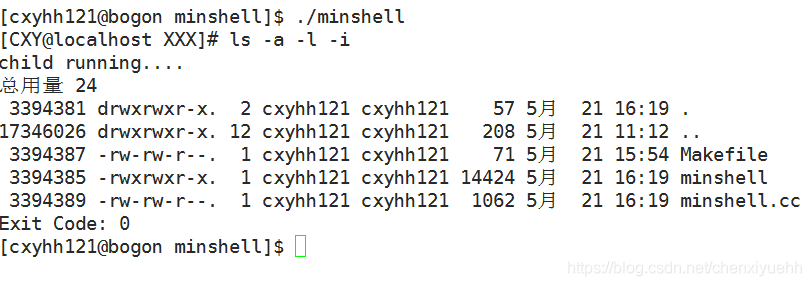进程替换
替换原理
- 用fork创建子进程后执行的是和父进程相同的程序(但有可能执行不同的代码分支),子进程往往要调用一种exec函数以执行另一个程序。
- 当进程调用一种exec函数时,该进程的用户空间代码和数据完全被新程序替换,从新程序的启动例程开始执行。
- 调用exec并不创建新进程,所以调用exec前后该进程的id并未改变

替换函数
其实有六种以exec开头的函数,统称exec函数:
#include <unistd.h>`
int execl(const char *path, const char *arg, ...);
int execlp(const char *file, const char *arg, ...);
int execle(const char *path, const char *arg, ...,char *const envp[]);
int execv(const char *path, char *const argv[]);
int execvp(const char *file, char *const argv[]
函数解释
- 这些函数如果调用成功则加载新的程序从启动代码开始执行,不再返回。
- 如果调用出错则返回-1
- 所以exec函数只有出错的返回值而没有成功的返回值。
命名理解
这些函数原型看起来很容易混,但只要掌握了规律就很好记。
- l(list) : 表示参数采用列表
- v(vector) : 参数用数组
- p(path) : 有p自动搜索环境变量PATH
- e(env) : 表示自己维护环境变量
exec调用举例如下:
#include <unistd.h>
int main()
{
char *const argv[] = { "ps", "-ef", NULL };
char *const envp[] = { "PATH=/bin:/usr/bin", "TERM=console", NULL };
execl("/bin/ps", "ps", "-ef", NULL);
// 带p的,可以使用环境变量PATH,无需写全路径
execlp("/bin/ps", "ps", "-ef", NULL);
// 带e的,需要自己组装环境变量
execle("/bin/ps", "ps", "-ef", NULL, envp);
execv("/bin/ps", argv);
// 带p的,可以使用环境变量PATH,无需写全路径
execvp("ps", argv);
// 带e的,需要自己组装环境变量
execve("/bin/ps", argv, envp);
exit(0);
}
minshell
- 之前我们讲到进程的控制以及我们今天讲的进程替换,综合这些知识我们就可以实现一个简单的shell(命令行解释器)
- 代码如下所示:
1 #include <stdio.h>
2 #include <iostream>
3 #include <cstdio>
4 #include <cstring>
5 #include <cstdlib>
6 #include <string>
7 #include <unistd.h>
8 #include <sys/types.h>
9 #include <sys/wait.h>
10
11 using namespace std;
12
13 #define NUM 32
14
15 int main()
16 {
17 char buff[1024] = {0};
18 string tips = "[CXY@localhost XXX]# ";//仿造一个命令行解释器提示符
19 cout << tips;
20 fgets(buff, sizeof(buff)-1, stdin);//从键盘中获取用户输入的信息,不能用cin,因为会有空格
21 buff[strlen(buff) - 1] = 0;
22
23 //ls -a -l -o -i
24 char *argv[NUM];//为使用替换函数execvp,创建该数组以传递命令
25 argv[0] = strtok(buff," ");//字符串分隔函数,将每个命令分隔
26 int i = 0;
27 while(argv[i] != NULL){
28 i++;
29 argv[i] = strtok(NULL," ");
30 }
31 pid_t id = fork();
32 if(id == 0){//child
33 cout << "child running...." << endl;
34 execvp(argv[0],argv);
35 exit(123);
36 }else{//father
37 int status = 0;
38 waitpid(id, &status, 0);//创建子进程去执行相关命令,父进程只要等就行了
39 cout << "Exit Code: "<< WEXITSTATUS(status) << endl;
40 }
41 return 0;
42 }
- 运行结果展示:
- 这里我们实现的命令行解释器只能执行Linux下80%的命令,像是管道符、重定向符这些命令无法实现,因为这些命令不是通过创建子进程来执行的。






















 683
683











 被折叠的 条评论
为什么被折叠?
被折叠的 条评论
为什么被折叠?








